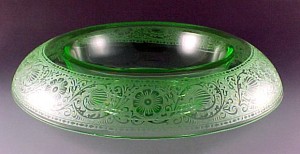This week's table is neither bold nor colorful. There are six place settings on a table that's literally scaled back (I removed the leaf). I was in a quietly reflective mood as I selected a vintage, soft, cream-colored Quaker Lace tablecloth. I was thinking of long-ago meals. Of tables set by ladies using their "Sunday best" china, crystal, flatware, and linens.
It's often said that the Golden Age of Hollywood began with "talkies" and continued through the early 1960s. During much the same era, something similar was happening with American glass, silver, and china companies. The best of them were creating beautiful, timeless products for American homes. There was a growing middle class of consumers clamoring for their products. Bridal registries became popular.
What those brides so lovingly selected is often available today at estate sales, in antiques shops, and on eBay. Many of the designs have become classics -- as beautiful today as when they were first produced.
 The china is by Lenox. It's identified only as H2. The pattern was introduced in 1911. It looks very similar to patterns still in production today.
The china is by Lenox. It's identified only as H2. The pattern was introduced in 1911. It looks very similar to patterns still in production today. The clear glass salad plates are Canterbury (1939-1955) by Duncan & Miller.
The clear glass salad plates are Canterbury (1939-1955) by Duncan & Miller. The silverplated flatware is Triumph (1941) by International Silver. The napkins are vintage.
The silverplated flatware is Triumph (1941) by International Silver. The napkins are vintage. The glassware is American (1915-1982) by Fostoria. Sometimes it's referred to as Early American. When I was a child, many of my mother's friends and relatives used American whenever they served company meals. I thought it was Fostoria's only pattern.
The glassware is American (1915-1982) by Fostoria. Sometimes it's referred to as Early American. When I was a child, many of my mother's friends and relatives used American whenever they served company meals. I thought it was Fostoria's only pattern.Below is the "tall water" glass. I often re-purpose older glassware. Since most dinners today have only one wine served throughout, this is a good size to use as a wine glass.
 Below is the "low water" glass. I like it better then the "iced beverage," because it has a slightly longer stem and a graceful shape.
Below is the "low water" glass. I like it better then the "iced beverage," because it has a slightly longer stem and a graceful shape. The small glass below is a sort of cousin of American. It's called American Lady. It features the cubist-patterned foot and stem, with a smooth, blown-glass bowl. For those who prefer colorful glassware, Fostoria also produced the pattern with a purple (amethyst) bowl -- those are stunning! The ones I'm using were marketed as champagne glasses, but I'd use them to serve a nice liqueur with dessert.
The small glass below is a sort of cousin of American. It's called American Lady. It features the cubist-patterned foot and stem, with a smooth, blown-glass bowl. For those who prefer colorful glassware, Fostoria also produced the pattern with a purple (amethyst) bowl -- those are stunning! The ones I'm using were marketed as champagne glasses, but I'd use them to serve a nice liqueur with dessert. The Quaker Lace Company of Philadelphia was regarded for over a century as the producer of America’s most desirable lace goods. The success of Quaker Lace depended in part on their ability to meet their middle-class customers’ desires for both luxury and durability.
The Quaker Lace Company of Philadelphia was regarded for over a century as the producer of America’s most desirable lace goods. The success of Quaker Lace depended in part on their ability to meet their middle-class customers’ desires for both luxury and durability.In 1918 President Woodrow Wilson asked Lenox to produce the White House's china service in lieu of previously chosen French made patterns. He was trying to fulfill a Congressional mandate of 1826 stipulating that everything used in the White House should be domestically produced. Previous Presidents had been unable to find domestic china deemed suitable to serve honored guests at the White House table, and they remained dependent on foreign-made tableware. Woodrow Wilson broke this precedent by ordering a 1700-piece tableware set from Lenox at a cost of $16,000. Since that time, Lenox has produced tableware for Presidents Roosevelt, Truman, Reagan, Clinton, and Bush.
 I've combined several different china patterns today. The creamer and sugar bowl are Claridge by Theodore Haviland. The pair of two-light candleholders is Duncan & Miller's Canterbury.
I've combined several different china patterns today. The creamer and sugar bowl are Claridge by Theodore Haviland. The pair of two-light candleholders is Duncan & Miller's Canterbury.Many of the American products I'm showing you today were strongly influenced by European designs. To add extra interest and color contrast, I included the Bavarian butter pat plates just before I took the pictures. I've used them as iced tea spoon rests before. It's always a problem to know what to do with an iced beverage spoon after using it. Rules of etiquette say flatware can't ever touch the table/tablecloth after being used.
I once saw iced tea spoons placed above the plate at a banquet in an elegant hotel. Is it "proper?" I don't know, but I like the look, and it saves space horizontally at each place setting.
 A closer view. I like the flowing, flame-shaped design of the candleholders.
A closer view. I like the flowing, flame-shaped design of the candleholders. A late 1800's French Haviland teapot. It's marked "CFH" on the bottom -- for Charles Field Haviland. Charles was the nephew of David Haviland, founder of the Haviland china dynasty. Charles Haviland was in business in Limoges, France, from 1859 until 1881. The European influences are obvious throughout all the "made in USA" products I'm showing you today. As Martha Stewart says (speaking specifically of the British), "They've taught us so much about gracious living."
A late 1800's French Haviland teapot. It's marked "CFH" on the bottom -- for Charles Field Haviland. Charles was the nephew of David Haviland, founder of the Haviland china dynasty. Charles Haviland was in business in Limoges, France, from 1859 until 1881. The European influences are obvious throughout all the "made in USA" products I'm showing you today. As Martha Stewart says (speaking specifically of the British), "They've taught us so much about gracious living."  I have Fostoria American salad plates but, to be honest, I think it looks more interesting to mix in a less "energetic" glassware pattern. Because of its popularity and long production run, there's a tremendous amount of American available. Most pieces (other than large serving pieces and rare items) are widely available at moderate prices.
I have Fostoria American salad plates but, to be honest, I think it looks more interesting to mix in a less "energetic" glassware pattern. Because of its popularity and long production run, there's a tremendous amount of American available. Most pieces (other than large serving pieces and rare items) are widely available at moderate prices. The coffee pot below is Theodore Haviland's Concorde, made in America. All Haviland china had been produced in Limoges, France, prior to 1936. Operations were moved back to Europe in 1958.
The coffee pot below is Theodore Haviland's Concorde, made in America. All Haviland china had been produced in Limoges, France, prior to 1936. Operations were moved back to Europe in 1958.Some trivia for you -- although the backstamp says "Theodore Haviland New York," Haviland was produced in America (using Haviland's porcelain formula, molds, decals, etc.) by Shenango Pottery of New Castle, Pennsylvania.
 A closer view of the tablecloth and the flatware:
A closer view of the tablecloth and the flatware: The coffee pot below is also Theodore Haviland. The pattern is Gotham (1945-1958). I was pleasantly surprised to see how well it coordinates with the Lenox china.
The coffee pot below is also Theodore Haviland. The pattern is Gotham (1945-1958). I was pleasantly surprised to see how well it coordinates with the Lenox china. Claridge (New York) is very similar to Gotham. They're the same shape, but Gotham has a gold band vs. Claridge's gold line.
Claridge (New York) is very similar to Gotham. They're the same shape, but Gotham has a gold band vs. Claridge's gold line. I felt that a simple centerpiece (with a tiny footprint) would be all this compressed table for six required. I cut a handful of lantana, and used a vintage etched glass budvase. It has a weighted sterling silver base.
I felt that a simple centerpiece (with a tiny footprint) would be all this compressed table for six required. I cut a handful of lantana, and used a vintage etched glass budvase. It has a weighted sterling silver base. I thought you might enjoy a look upward ...
I thought you might enjoy a look upward ... Is this table old-fashioned? I think so. Traditional? Absolutely!
Is this table old-fashioned? I think so. Traditional? Absolutely!Un-cool? Perhaps -- I sort of hope so!
It's been a long time since I tried to be hip, or cool, or modern. That was when I was young and foolish -- and hadn't developed an appreciation of the timeless qualities of things cherished by previous generations.
 Candlelight and Fosteria's American pattern make agreeable dinner companions. I added a mayonnaise bowl and underplate after I'd already begun taking photographs. The little red spots in the bowl are fallen lantana petals.
Candlelight and Fosteria's American pattern make agreeable dinner companions. I added a mayonnaise bowl and underplate after I'd already begun taking photographs. The little red spots in the bowl are fallen lantana petals. The only new items on the table are the tall Mikasa salt and pepper shakers and the inexpensive crystal tealight holders. Otherwise, it could have been a table set by our mothers, grandmothers, aunts, great-aunts, teachers, family friends ...
The only new items on the table are the tall Mikasa salt and pepper shakers and the inexpensive crystal tealight holders. Otherwise, it could have been a table set by our mothers, grandmothers, aunts, great-aunts, teachers, family friends ...Does any of it remind you of a special person in your life or bring back memories from childhood?
 Maybe I'll do a better flower arrangement for you next time ...
Maybe I'll do a better flower arrangement for you next time ... Or perhaps I'll fill this Canterbury bowl with fruit ...
Or perhaps I'll fill this Canterbury bowl with fruit ... Or floating candles ...
Or floating candles ... Thank you for joining me today. I hope you'll visit Susan and all her talented participants for the 101st Tablescape Thursday!
Thank you for joining me today. I hope you'll visit Susan and all her talented participants for the 101st Tablescape Thursday!







































